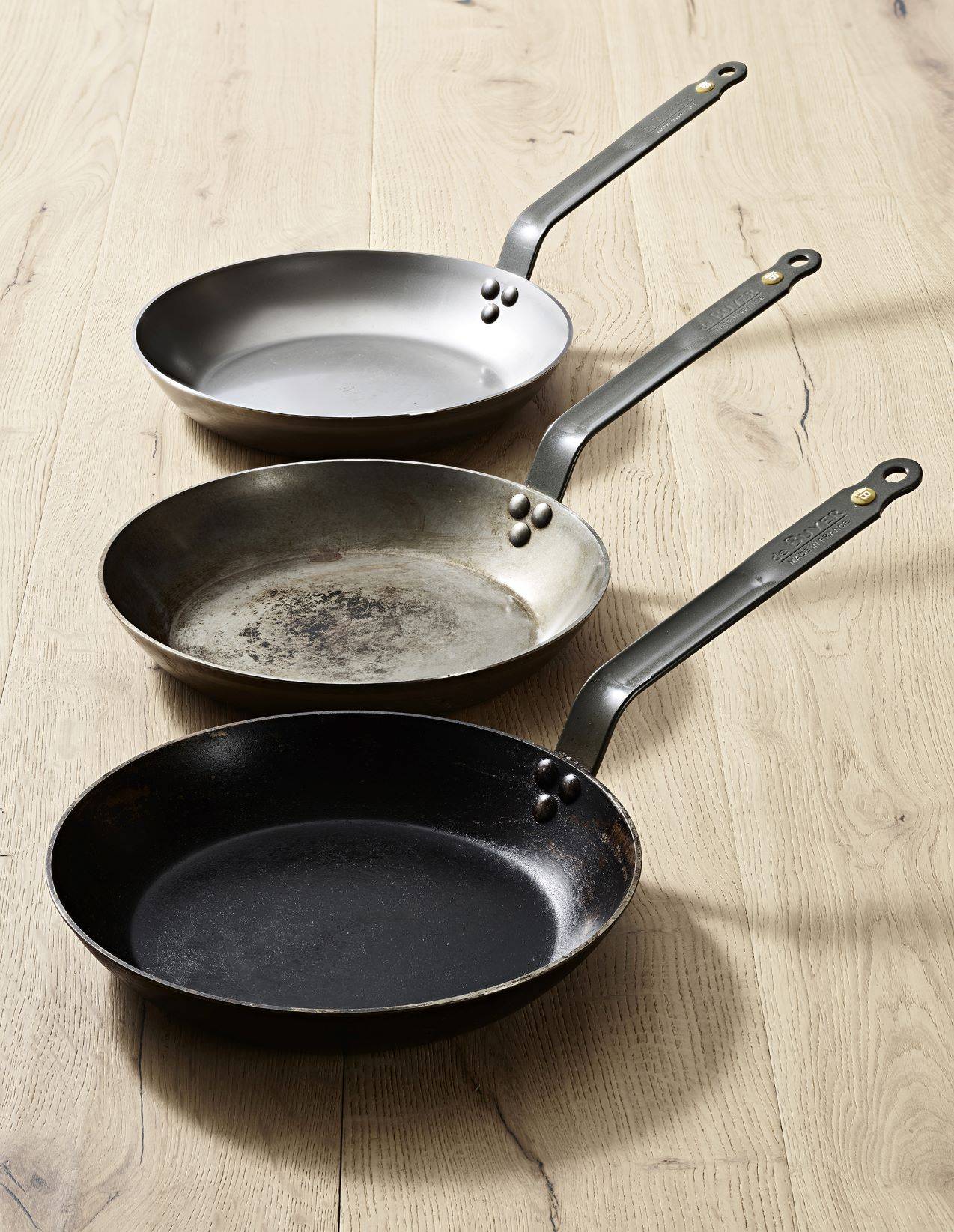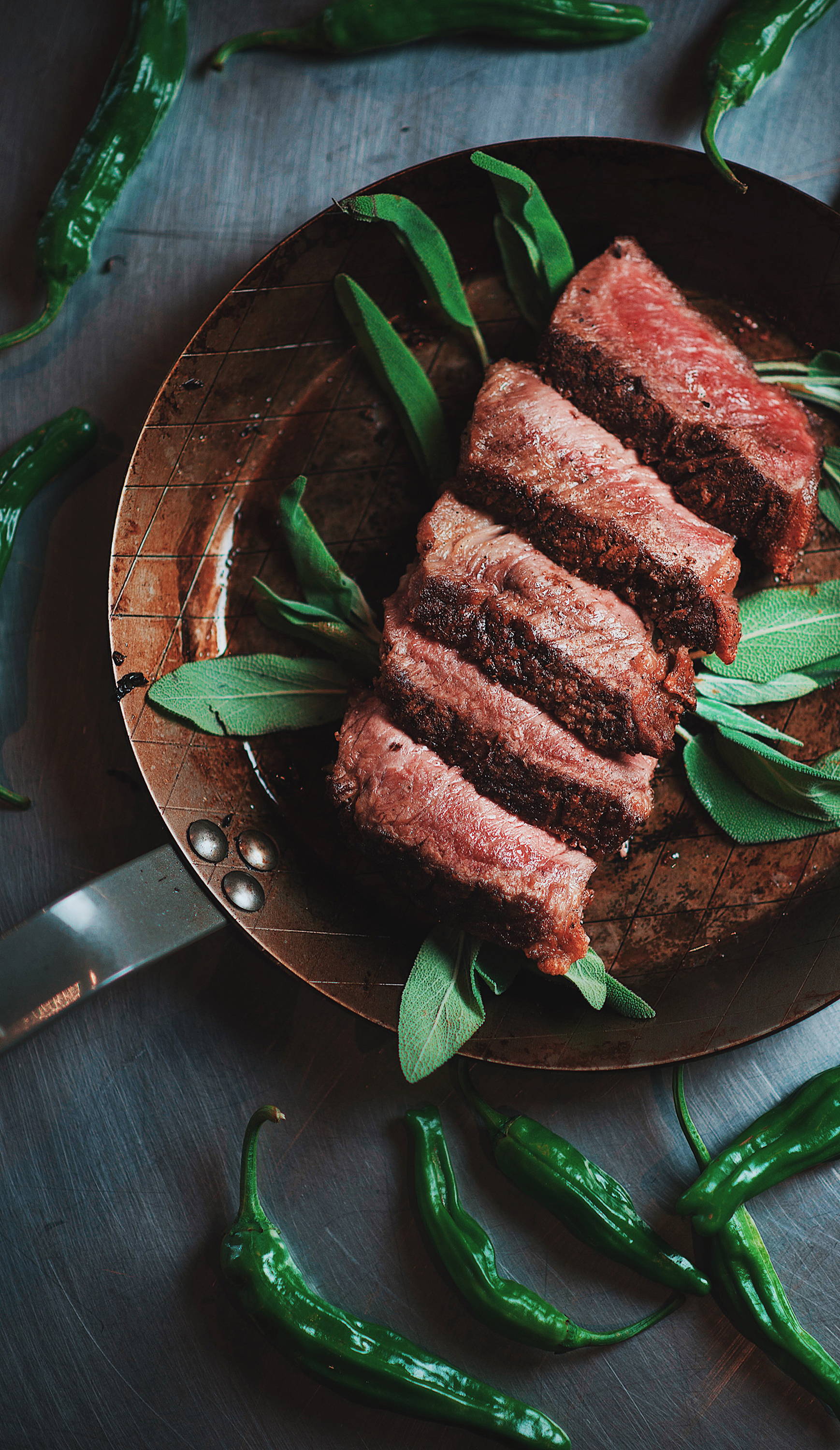Carbon Steel Tips and Tricks
We've gathered some quick tips from de Buyer employees, fans, and customers to make your carbon steel experience even better.
If you have any tips or advice you would like to share, let us know!
Submit your tips here!
Cleaning and Seasoning
What is Carbon Steel?
Cleaning and seasoning your new pan
Congratulations on receiving your new Carbon Steel Pan! After removing it from the packaging, your first step should be to wash your pan with hot water and soap with a scrubber brush or the rough side of your kitchen sponge in order to remove the natural beeswax coating. It is okay if a little bit of beeswax remains.
Step two is to choose an oil with a high smoke point. We recommend using one of these oils to season your new pan: grapeseed oil, avocado oil, peanut oil, canola oil, sunflower oil. Our personal favorite is grapeseed or avocado oil because it has the highest smoke point and a neutral flavor. We do NOT recommend using: olive oil, flaxseed oil, coconut oil or ghee.
Pour a very thin layer of oil into a cool pan and use a paper towel to spread it across the entire cooking surface of the pan. Heat the pan over medium-high heat for about 10 minutes, until the oil starts to smoke then remove it from the heat. Wait for any excess oil to cool off before pouring it out (don't pour it down the sink drain!).
Try seasoning your pan 2-3 times before first use and then start cooking with it! This will create wonderful nonstick base right off the bat and will just keep getting better with each use!
For products that are oven safe, you can follow the same process of choosing a high smoke-point oil and using a paper towel to rub the oil all over the inside and the outside of your pan. Then place your pan upside down in the oven at 450F and bake it for 1 hour.
If your pan is not totally black, that doesn't mean it is not seasoned well!
During the seasoning process, you will notice a few changes in your pan. As your pan builds up more of a seasoning, the surface will start to get darker, and in some cases turn from silver to completely black. This is normal!
But, a common misconception is that your pan has to be perfectly black for it to be seasoned properly and that is not the case! The coloring in your pan will vary based on what you cook, how often you use it, the seasoning method you used, the type of oils you use, and how you care for it. If your pan is not totally black, that doesn't mean it is not seasoned well!
Cleaning your carbon steel
The best way to clean your pan is to rinse it in hot water, wipe dry with paper towels and place it back on the stove to dry thoroughly.
While this pan will become mostly nonstick after seasoning, there will always be certain foods that might get stuck. To remove stuck-on bits and pieces, pour some hot water into your pan while it is still warm to deglaze and scrape off the stuck-on pieces of food. Rinse this out, repeat if necessary, and follow the above steps for drying.
Carbon Steel is NOT dishwasher safe, and any harsh soaps or detergents should be avoided. This will help to preserve your pan's seasoning and keep your pan from rusting.
Rust Prevention
Due to the laws of nature, rust can commonly appear on your carbon steel pans if not stored or cared for properly. To prevent rusting, be sure to always thoroughly dry your pan after washing it by wiping it down with a paper towel, then placing it back on the stove and heating it over medium heat to evaporate any remaining moisture. Once dry, put a little bit of oil on a paper towel and wipe down the surface of the pan before storing it away in a dry place.
Rust Removal
If rust does build, there are a few ways that it can be removed.
1. Salt Scrub: pour some course salt into the pan and with a paper towel, scrub the areas that have rusted.
2. Scour the rusted areas with a scouring pad, steel wool, or something more coarse to remove the rust from the pan.
3. Use a mixture of vinegar and water and soak the rusted areas. This should loosen the rust and allow you to scrub it off more easily.
After using any of these methods, you will likely have to re-season your pan to build up the patina again - this will naturally protect the metal from rusting.

Cooking with Carbon Steel
Using your carbon steel in the oven
While not all of our product are oven safe - we have a variety of pans that can be used seamlessly between the stove top and in the oven. Only the Mineral B pans that feature a cast stainless steel handle are considered fully oven-safe: Mineral B PRO Fry Pan, Mineral B PRO Country Fry Pan, Mineral B Country Fry Pan with 2 handles, Mineral B Paella Pan, and Mineral B Oval Roasting Pan. All other Mineral B pans can be used for "flash" oven use for up to 10 minutes at 400F.
Using your carbon steel on the grill
How to avoid warping
de Buyer Carbon steel is thicker than the average carbon steel pan on the market. This allows it to be more warp-resistant than most, however it is still possible for your pan to warp if not cared for properly. To keep your pan from warping, be sure to avoid rapid changes in temperature.
If working with an induction or electric stove top, be sure to always match the size of the pan to the size of the coil or burner that you are cooking on, and be sure to gradually increase the temperature on the burner when heating up your pan. Heating the pan up too quickly can "shock" the pan, causing it to warp.
After cooking with your carbon steel pan, never put it in contact with cold water if the pan is still hot. If you need to deglaze your pan to make a sauce or to remove stuck on bits, make sure to pour HOT liquid (water, broth, etc.) into the HOT pan to avoid the rapid temperature change.
As a general rule of thumb, be sure to always heat up and cool down your pan gradually to keep it in it's best shape.
Do not use a lid with carbon steel fry pans
Many uses of our Crepe & Tortilla pans
Many uses of our Mineral B Paella Pan
